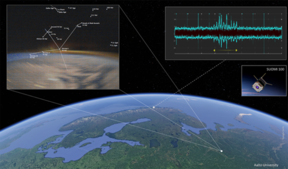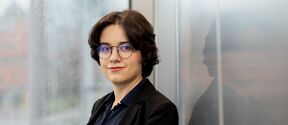Suomi 100 did what could previously be done only by much larger satellites: photographing and studying the aurora borealis

Picture of the new measurements by the Suomi 100 satellite. A photograph of the aurora borealis (upper left corner) and the satellite's radio wave measurement made in the following year above the EISCAT transmitter (upper right corner). The Aquila constellation which can be seen behind the aurora has been added by hand behind the aurora borealis image. The unbroken white lines indicate the direction of the camera the moment that the picture was taken. The dot at the end of the broken line shows the location of the EISCAT transmitter. Suomi 100 is a cube satellite with a volume of one litre (photograph on the right in the middle). Photo: Aalto University
Suomi 100, the signature satellite marking the centenary of Finnish independence, has circled the earth at a height of 600 kilometres for more than three years.
The effort has made excellent progress, says the head of the project, Esa Kallio, Professor of Space Science and Technology.
“We have taken pictures of the aurora borealis with the camera on Suomi 100 and have made unique measurements in the aurora area. To our knowledge, this is the first time that a CubeSat satellite has managed to do this.”
CubeSat is a popular satellite standard in the world. The basic size of these satellites is 10 cm x 10 cm x 10 cm, which corresponds to the volume of a one-litre carton of milk, and the maximum weight is 1.3 kg. The cubes can also be combined to form larger satellites comprising two or three units. The standard reduces the costs of both construction and launch, as adapters of the same size can be used in the launching of all CubeSat satellites.
One milk-carton sized Suomi 100 space research satellite carries two research devices - a wide-angle camera and radio equipment. In a fresh research report, the scientists analyse a picture taken of the aurora borealis by linking it with photographs taken from terrestrial aurora cameras and with magnetic field measurements.
“According to the research, the red and green aurora colours that show in the photograph are located in the area between Northern Finland and Greenland”, Kallio says, emphasising that the circular motion makes using it to get pictures of the aurora with it a challenging task for the small satellite.
“On the other hand, above the clouds it is possible to get images of auroras that do not get noticed at ground level.”
New information on particles that cause the aurora borealis
The Suomi 100 radio device makes observations of radio waves - both those that are broadcast from the surface of the earth, and ones that occur naturally in space. The satellite team took part in the research together with the international EISCAT research community by receiving radio waves broadcast from Tromsø, Norway using an ionosphere heater.
The measurements were made in such a way that the heater was on at the exact time that Suomi 100 was above it. This is believed to be the first time that joint measurement has been made of the aurora borealis area involving a small satellite of the CubeSat class and a terrestrial radio heating transmitter using the high-frequency range. Measurements presented in the group's second new research report showed how the radio waves cause the temperature of particles in the aurora borealis zone to rise.
The aurora borealis is a fascinating topic for space physicists because it shows how the sun affects the upper atmosphere of the earth. The topic is also important for the safety and function of society because space weather affects air traffic, satellites, as well as telecommunication networks and electricity grids.
“We have managed to show that a small satellite can be used to study many things that used to be done by satellites that are 100 times larger. This opens completely new opportunities for research”, Esa Kallio says.
In the new measurement campaign, Suomi 100 is making increasingly detailed measurements together with an EISCAT radar and other measuring devices. The Suomi 100 satellite is a successful technical and scientific project and it will continue to be used in the research of space weather in the coming years.
Research publications that are still awaiting peer review on measurements using a radio device (https://arxiv.org/ftp/arxiv/papers/2206/2206.01917.pdf ) and a camera (https://arxiv.org/ftp/arxiv/papers/2206/2206.01915.pdf) can be found in arXiv.
In addition to Aalto University, participants in the publications that were sent out include researchers from the Finnish Meteorological Institute, the University of Oulu, and the University of Bergen in Norway. The Suomi 100 satellite project is led by Aalto University and was implemented together with the Finnish Meteorological Institute. The project got economic support from the Finland 100 centenary year project and from the Magnus Ehrnrooth Foundation.
The satellite project homepage: http://www.suomi100satelliitti.fi/.
EISCAT project homepage in English: https://eiscat.se/about/.
Read more news

Future makers research batteries, cryptography and plastic recycling
The Technology Industries of Finland Centennial Foundation awarded 3.5 million euros in research funding to eight projects, five from Aalto University.
The pilot project for direct article delivery from the National Repository Library ends
Aalto University has been participated in the pilot project for direct article delivery with the National Repository Library and Kopiosto from 2023 to 2025. The pilot ends on 19th December.
Meet the new ELLIS Institute PIs: Azade Farshad advances AI for medical applications
Farshad’s research background is in computer vision and generative models.






